Annotated Bibliography: Assessing Business Student Work Readiness
VerifiedAdded on 2020/04/21
|8
|1813
|135
Annotated Bibliography
AI Summary
This annotated bibliography examines the critical issue of business student work readiness, drawing on multiple scholarly sources to analyze the skills gap and employability challenges. The bibliography includes summaries and evaluations of articles exploring various facets of this topic, such as the assessment of competency models, the transfer of employability skills, student perceptions of skill importance, and the perspectives of students on workplace preparedness. The sources also delve into the significance of employability skills in the UK labor market and the role of higher education institutions in preparing students for the workforce. The analysis covers the methodologies used, the key findings, and the implications of the research for business students, educators, and employers, providing a comprehensive overview of the current state of business graduate employability and the steps needed to improve it.
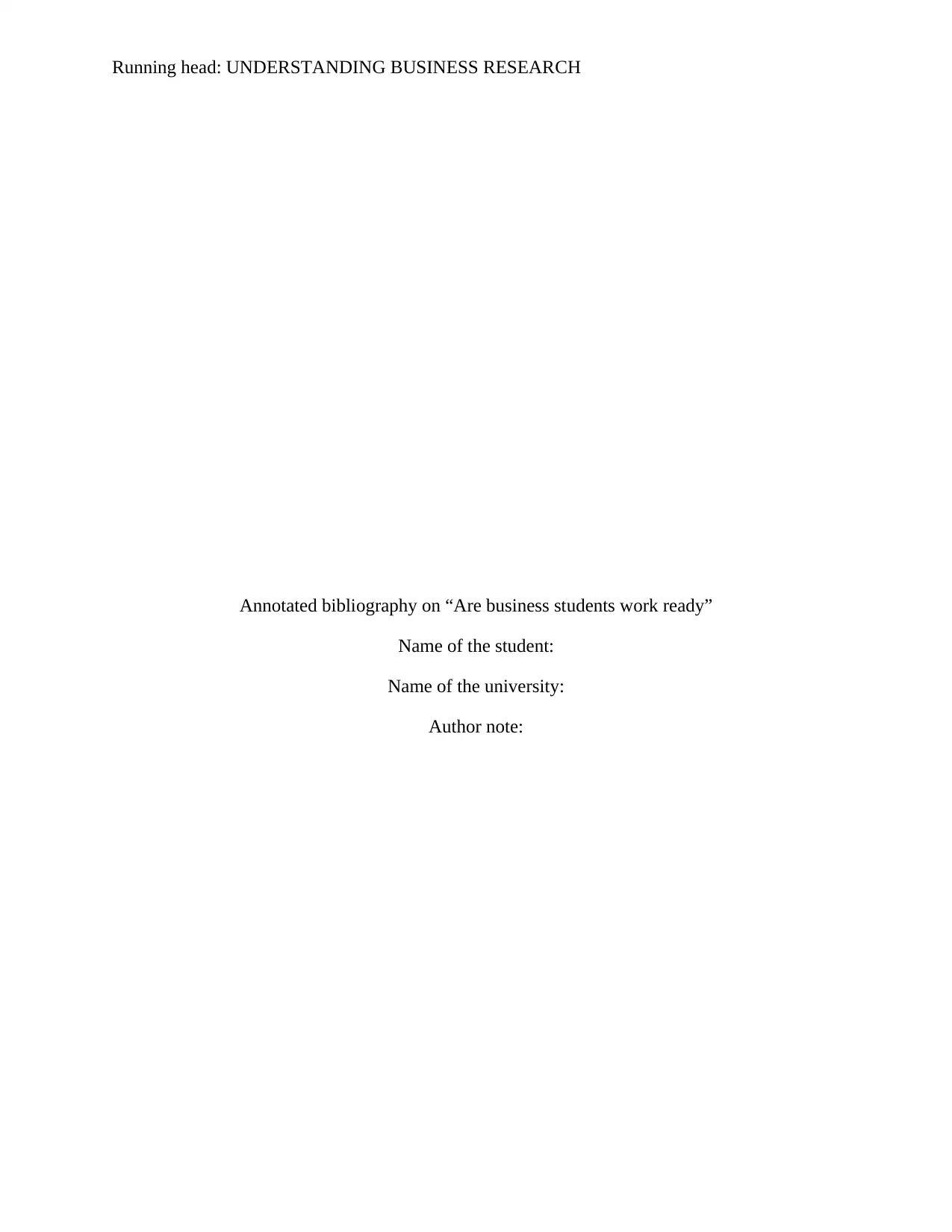
Running head: UNDERSTANDING BUSINESS RESEARCH
Annotated bibliography on “Are business students work ready”
Name of the student:
Name of the university:
Author note:
Annotated bibliography on “Are business students work ready”
Name of the student:
Name of the university:
Author note:
Paraphrase This Document
Need a fresh take? Get an instant paraphrase of this document with our AI Paraphraser
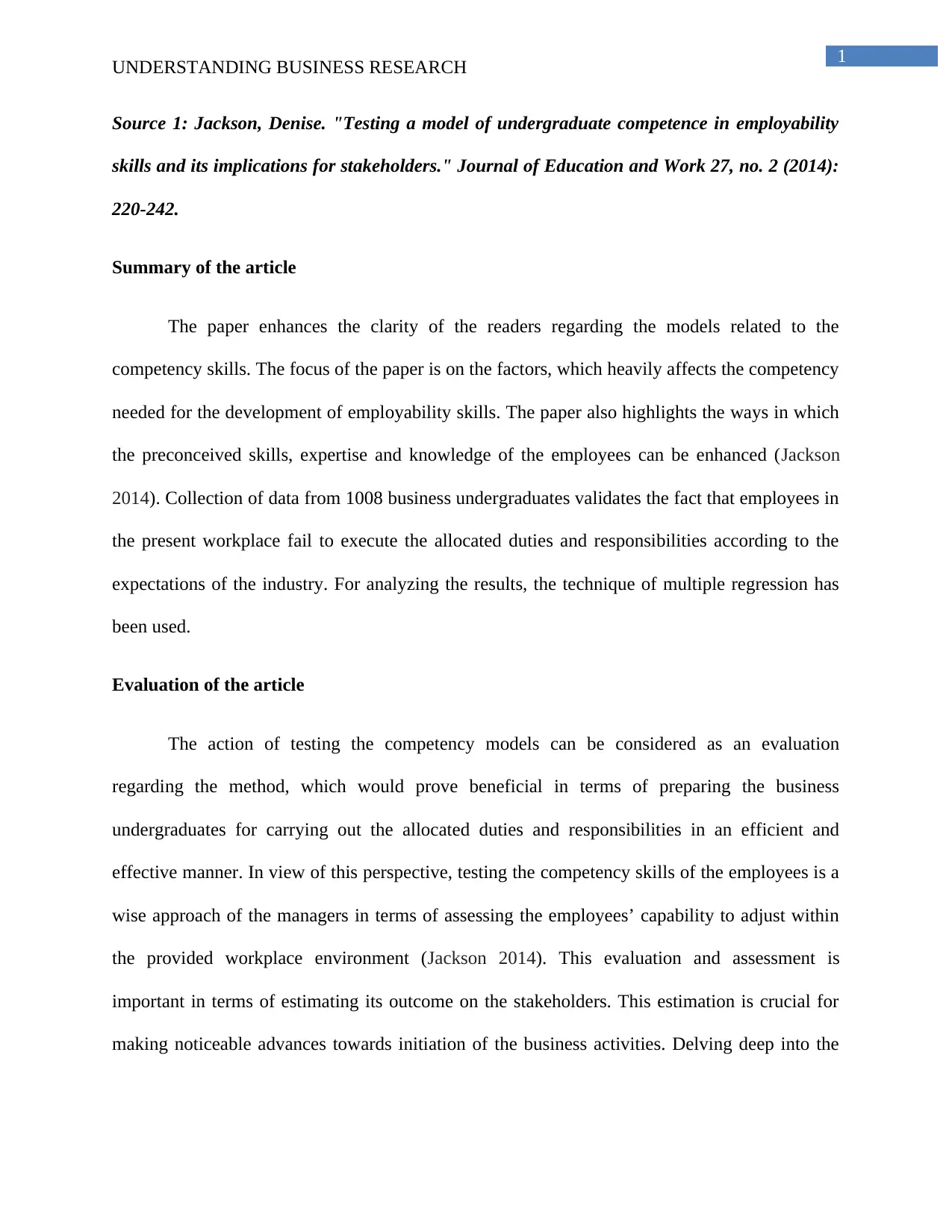
1
UNDERSTANDING BUSINESS RESEARCH
Source 1: Jackson, Denise. "Testing a model of undergraduate competence in employability
skills and its implications for stakeholders." Journal of Education and Work 27, no. 2 (2014):
220-242.
Summary of the article
The paper enhances the clarity of the readers regarding the models related to the
competency skills. The focus of the paper is on the factors, which heavily affects the competency
needed for the development of employability skills. The paper also highlights the ways in which
the preconceived skills, expertise and knowledge of the employees can be enhanced (Jackson
2014). Collection of data from 1008 business undergraduates validates the fact that employees in
the present workplace fail to execute the allocated duties and responsibilities according to the
expectations of the industry. For analyzing the results, the technique of multiple regression has
been used.
Evaluation of the article
The action of testing the competency models can be considered as an evaluation
regarding the method, which would prove beneficial in terms of preparing the business
undergraduates for carrying out the allocated duties and responsibilities in an efficient and
effective manner. In view of this perspective, testing the competency skills of the employees is a
wise approach of the managers in terms of assessing the employees’ capability to adjust within
the provided workplace environment (Jackson 2014). This evaluation and assessment is
important in terms of estimating its outcome on the stakeholders. This estimation is crucial for
making noticeable advances towards initiation of the business activities. Delving deep into the
UNDERSTANDING BUSINESS RESEARCH
Source 1: Jackson, Denise. "Testing a model of undergraduate competence in employability
skills and its implications for stakeholders." Journal of Education and Work 27, no. 2 (2014):
220-242.
Summary of the article
The paper enhances the clarity of the readers regarding the models related to the
competency skills. The focus of the paper is on the factors, which heavily affects the competency
needed for the development of employability skills. The paper also highlights the ways in which
the preconceived skills, expertise and knowledge of the employees can be enhanced (Jackson
2014). Collection of data from 1008 business undergraduates validates the fact that employees in
the present workplace fail to execute the allocated duties and responsibilities according to the
expectations of the industry. For analyzing the results, the technique of multiple regression has
been used.
Evaluation of the article
The action of testing the competency models can be considered as an evaluation
regarding the method, which would prove beneficial in terms of preparing the business
undergraduates for carrying out the allocated duties and responsibilities in an efficient and
effective manner. In view of this perspective, testing the competency skills of the employees is a
wise approach of the managers in terms of assessing the employees’ capability to adjust within
the provided workplace environment (Jackson 2014). This evaluation and assessment is
important in terms of estimating its outcome on the stakeholders. This estimation is crucial for
making noticeable advances towards initiation of the business activities. Delving deep into the
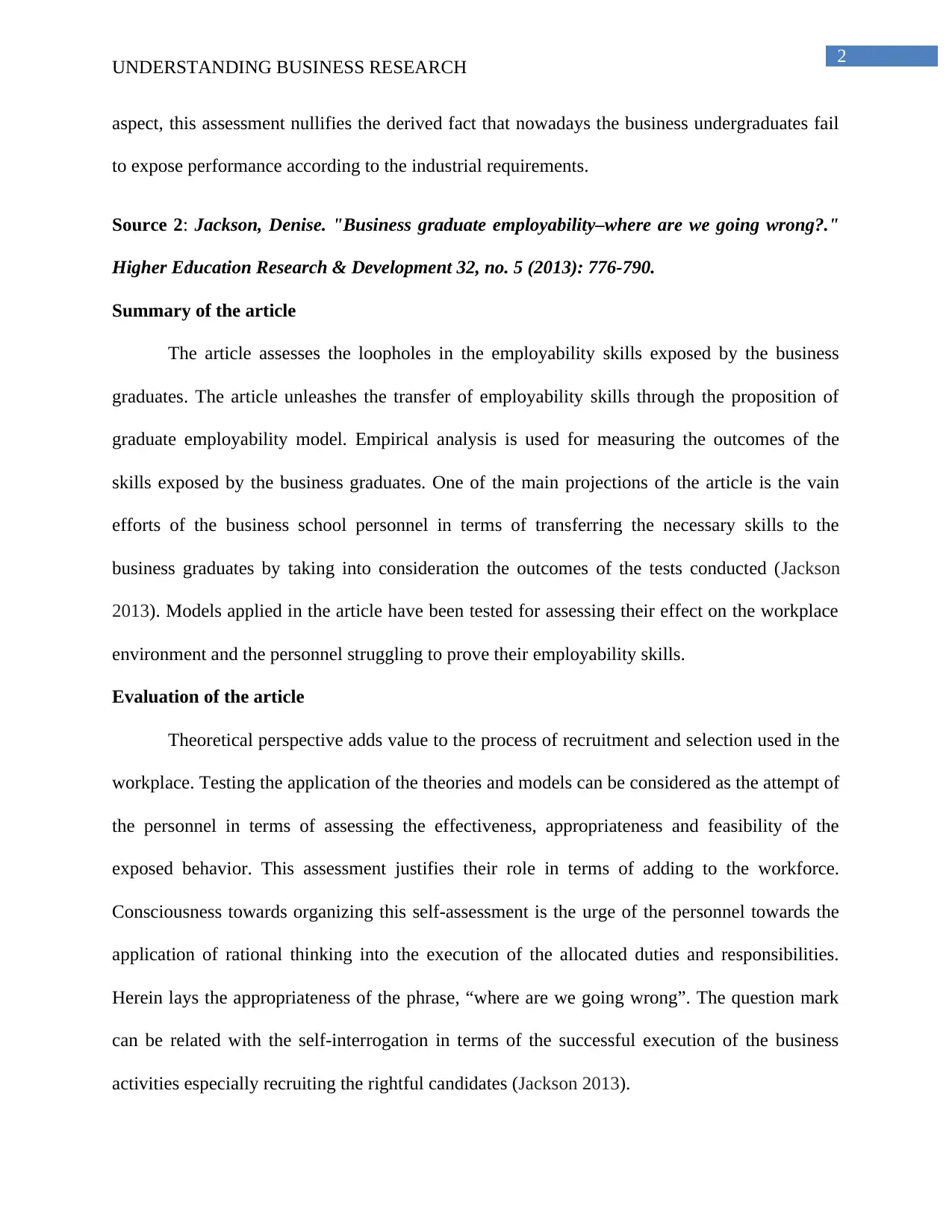
2
UNDERSTANDING BUSINESS RESEARCH
aspect, this assessment nullifies the derived fact that nowadays the business undergraduates fail
to expose performance according to the industrial requirements.
Source 2: Jackson, Denise. "Business graduate employability–where are we going wrong?."
Higher Education Research & Development 32, no. 5 (2013): 776-790.
Summary of the article
The article assesses the loopholes in the employability skills exposed by the business
graduates. The article unleashes the transfer of employability skills through the proposition of
graduate employability model. Empirical analysis is used for measuring the outcomes of the
skills exposed by the business graduates. One of the main projections of the article is the vain
efforts of the business school personnel in terms of transferring the necessary skills to the
business graduates by taking into consideration the outcomes of the tests conducted (Jackson
2013). Models applied in the article have been tested for assessing their effect on the workplace
environment and the personnel struggling to prove their employability skills.
Evaluation of the article
Theoretical perspective adds value to the process of recruitment and selection used in the
workplace. Testing the application of the theories and models can be considered as the attempt of
the personnel in terms of assessing the effectiveness, appropriateness and feasibility of the
exposed behavior. This assessment justifies their role in terms of adding to the workforce.
Consciousness towards organizing this self-assessment is the urge of the personnel towards the
application of rational thinking into the execution of the allocated duties and responsibilities.
Herein lays the appropriateness of the phrase, “where are we going wrong”. The question mark
can be related with the self-interrogation in terms of the successful execution of the business
activities especially recruiting the rightful candidates (Jackson 2013).
UNDERSTANDING BUSINESS RESEARCH
aspect, this assessment nullifies the derived fact that nowadays the business undergraduates fail
to expose performance according to the industrial requirements.
Source 2: Jackson, Denise. "Business graduate employability–where are we going wrong?."
Higher Education Research & Development 32, no. 5 (2013): 776-790.
Summary of the article
The article assesses the loopholes in the employability skills exposed by the business
graduates. The article unleashes the transfer of employability skills through the proposition of
graduate employability model. Empirical analysis is used for measuring the outcomes of the
skills exposed by the business graduates. One of the main projections of the article is the vain
efforts of the business school personnel in terms of transferring the necessary skills to the
business graduates by taking into consideration the outcomes of the tests conducted (Jackson
2013). Models applied in the article have been tested for assessing their effect on the workplace
environment and the personnel struggling to prove their employability skills.
Evaluation of the article
Theoretical perspective adds value to the process of recruitment and selection used in the
workplace. Testing the application of the theories and models can be considered as the attempt of
the personnel in terms of assessing the effectiveness, appropriateness and feasibility of the
exposed behavior. This assessment justifies their role in terms of adding to the workforce.
Consciousness towards organizing this self-assessment is the urge of the personnel towards the
application of rational thinking into the execution of the allocated duties and responsibilities.
Herein lays the appropriateness of the phrase, “where are we going wrong”. The question mark
can be related with the self-interrogation in terms of the successful execution of the business
activities especially recruiting the rightful candidates (Jackson 2013).
⊘ This is a preview!⊘
Do you want full access?
Subscribe today to unlock all pages.

Trusted by 1+ million students worldwide
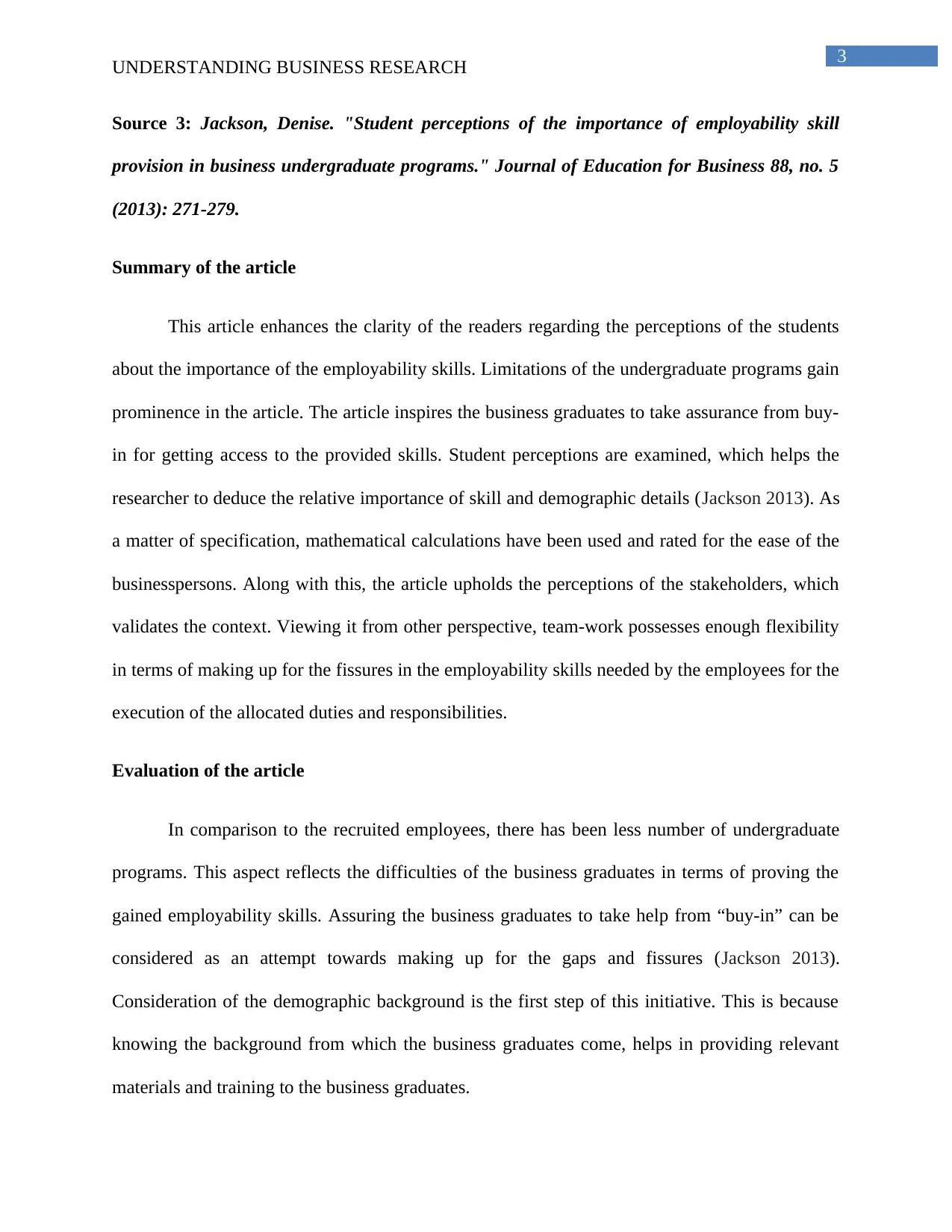
3
UNDERSTANDING BUSINESS RESEARCH
Source 3: Jackson, Denise. "Student perceptions of the importance of employability skill
provision in business undergraduate programs." Journal of Education for Business 88, no. 5
(2013): 271-279.
Summary of the article
This article enhances the clarity of the readers regarding the perceptions of the students
about the importance of the employability skills. Limitations of the undergraduate programs gain
prominence in the article. The article inspires the business graduates to take assurance from buy-
in for getting access to the provided skills. Student perceptions are examined, which helps the
researcher to deduce the relative importance of skill and demographic details (Jackson 2013). As
a matter of specification, mathematical calculations have been used and rated for the ease of the
businesspersons. Along with this, the article upholds the perceptions of the stakeholders, which
validates the context. Viewing it from other perspective, team-work possesses enough flexibility
in terms of making up for the fissures in the employability skills needed by the employees for the
execution of the allocated duties and responsibilities.
Evaluation of the article
In comparison to the recruited employees, there has been less number of undergraduate
programs. This aspect reflects the difficulties of the business graduates in terms of proving the
gained employability skills. Assuring the business graduates to take help from “buy-in” can be
considered as an attempt towards making up for the gaps and fissures (Jackson 2013).
Consideration of the demographic background is the first step of this initiative. This is because
knowing the background from which the business graduates come, helps in providing relevant
materials and training to the business graduates.
UNDERSTANDING BUSINESS RESEARCH
Source 3: Jackson, Denise. "Student perceptions of the importance of employability skill
provision in business undergraduate programs." Journal of Education for Business 88, no. 5
(2013): 271-279.
Summary of the article
This article enhances the clarity of the readers regarding the perceptions of the students
about the importance of the employability skills. Limitations of the undergraduate programs gain
prominence in the article. The article inspires the business graduates to take assurance from buy-
in for getting access to the provided skills. Student perceptions are examined, which helps the
researcher to deduce the relative importance of skill and demographic details (Jackson 2013). As
a matter of specification, mathematical calculations have been used and rated for the ease of the
businesspersons. Along with this, the article upholds the perceptions of the stakeholders, which
validates the context. Viewing it from other perspective, team-work possesses enough flexibility
in terms of making up for the fissures in the employability skills needed by the employees for the
execution of the allocated duties and responsibilities.
Evaluation of the article
In comparison to the recruited employees, there has been less number of undergraduate
programs. This aspect reflects the difficulties of the business graduates in terms of proving the
gained employability skills. Assuring the business graduates to take help from “buy-in” can be
considered as an attempt towards making up for the gaps and fissures (Jackson 2013).
Consideration of the demographic background is the first step of this initiative. This is because
knowing the background from which the business graduates come, helps in providing relevant
materials and training to the business graduates.
Paraphrase This Document
Need a fresh take? Get an instant paraphrase of this document with our AI Paraphraser
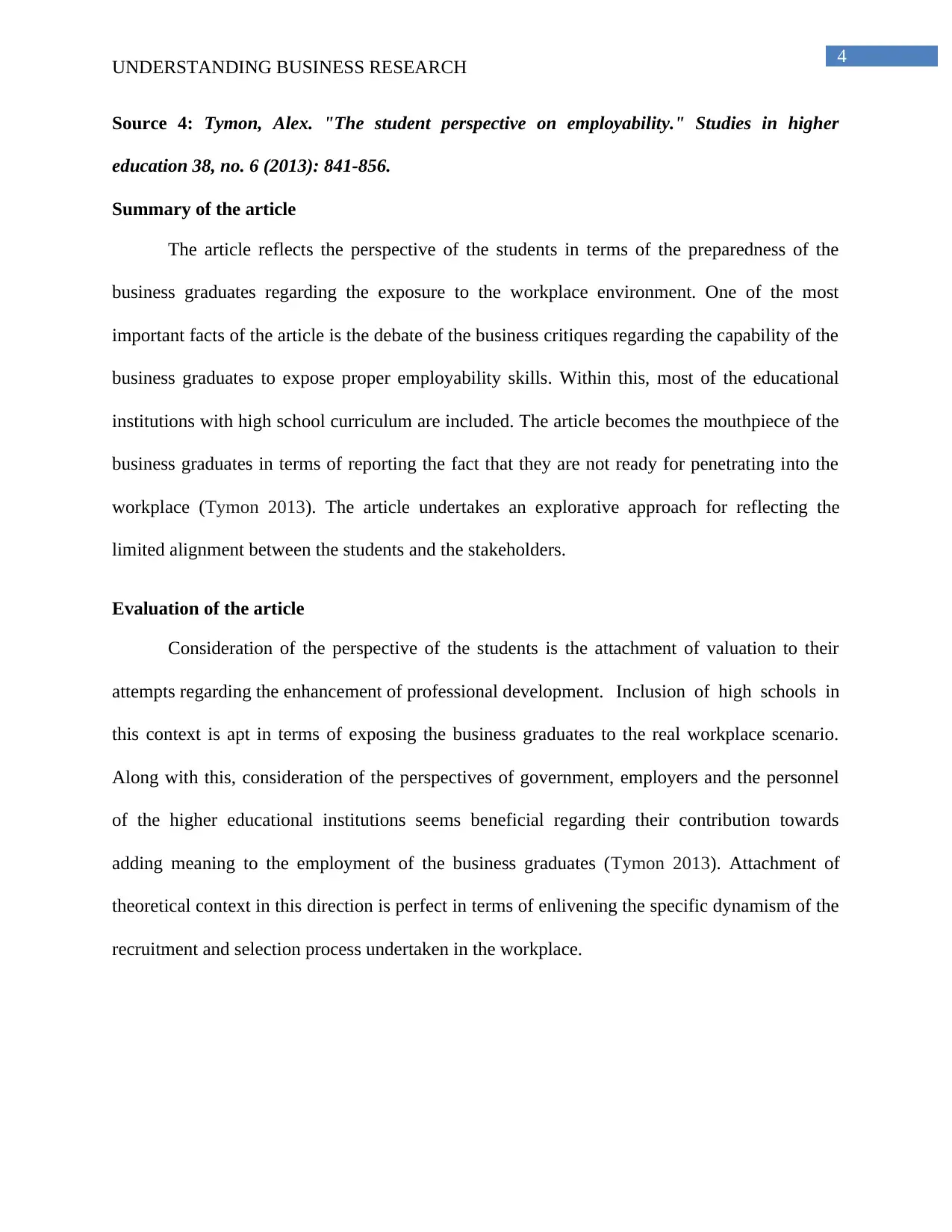
4
UNDERSTANDING BUSINESS RESEARCH
Source 4: Tymon, Alex. "The student perspective on employability." Studies in higher
education 38, no. 6 (2013): 841-856.
Summary of the article
The article reflects the perspective of the students in terms of the preparedness of the
business graduates regarding the exposure to the workplace environment. One of the most
important facts of the article is the debate of the business critiques regarding the capability of the
business graduates to expose proper employability skills. Within this, most of the educational
institutions with high school curriculum are included. The article becomes the mouthpiece of the
business graduates in terms of reporting the fact that they are not ready for penetrating into the
workplace (Tymon 2013). The article undertakes an explorative approach for reflecting the
limited alignment between the students and the stakeholders.
Evaluation of the article
Consideration of the perspective of the students is the attachment of valuation to their
attempts regarding the enhancement of professional development. Inclusion of high schools in
this context is apt in terms of exposing the business graduates to the real workplace scenario.
Along with this, consideration of the perspectives of government, employers and the personnel
of the higher educational institutions seems beneficial regarding their contribution towards
adding meaning to the employment of the business graduates (Tymon 2013). Attachment of
theoretical context in this direction is perfect in terms of enlivening the specific dynamism of the
recruitment and selection process undertaken in the workplace.
UNDERSTANDING BUSINESS RESEARCH
Source 4: Tymon, Alex. "The student perspective on employability." Studies in higher
education 38, no. 6 (2013): 841-856.
Summary of the article
The article reflects the perspective of the students in terms of the preparedness of the
business graduates regarding the exposure to the workplace environment. One of the most
important facts of the article is the debate of the business critiques regarding the capability of the
business graduates to expose proper employability skills. Within this, most of the educational
institutions with high school curriculum are included. The article becomes the mouthpiece of the
business graduates in terms of reporting the fact that they are not ready for penetrating into the
workplace (Tymon 2013). The article undertakes an explorative approach for reflecting the
limited alignment between the students and the stakeholders.
Evaluation of the article
Consideration of the perspective of the students is the attachment of valuation to their
attempts regarding the enhancement of professional development. Inclusion of high schools in
this context is apt in terms of exposing the business graduates to the real workplace scenario.
Along with this, consideration of the perspectives of government, employers and the personnel
of the higher educational institutions seems beneficial regarding their contribution towards
adding meaning to the employment of the business graduates (Tymon 2013). Attachment of
theoretical context in this direction is perfect in terms of enlivening the specific dynamism of the
recruitment and selection process undertaken in the workplace.
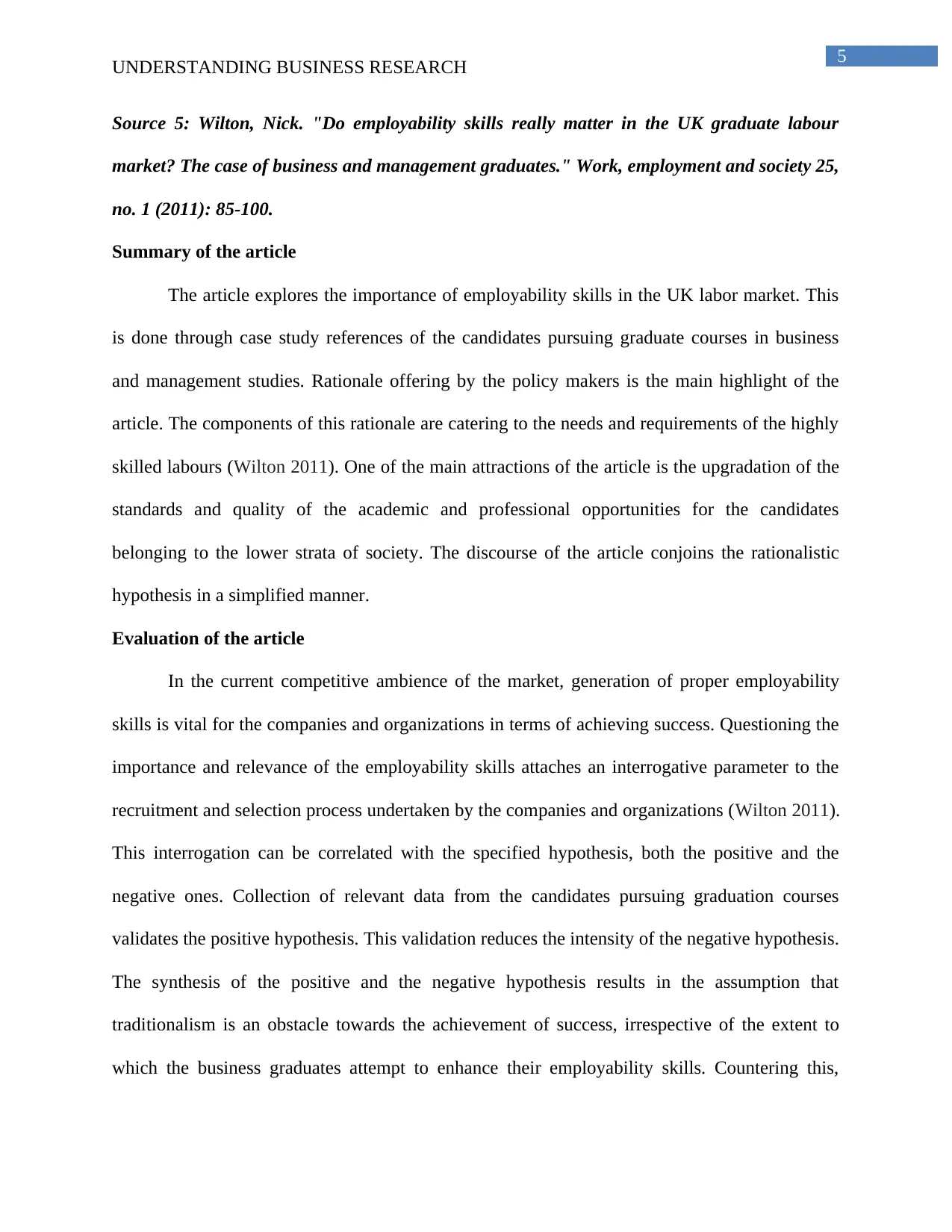
5
UNDERSTANDING BUSINESS RESEARCH
Source 5: Wilton, Nick. "Do employability skills really matter in the UK graduate labour
market? The case of business and management graduates." Work, employment and society 25,
no. 1 (2011): 85-100.
Summary of the article
The article explores the importance of employability skills in the UK labor market. This
is done through case study references of the candidates pursuing graduate courses in business
and management studies. Rationale offering by the policy makers is the main highlight of the
article. The components of this rationale are catering to the needs and requirements of the highly
skilled labours (Wilton 2011). One of the main attractions of the article is the upgradation of the
standards and quality of the academic and professional opportunities for the candidates
belonging to the lower strata of society. The discourse of the article conjoins the rationalistic
hypothesis in a simplified manner.
Evaluation of the article
In the current competitive ambience of the market, generation of proper employability
skills is vital for the companies and organizations in terms of achieving success. Questioning the
importance and relevance of the employability skills attaches an interrogative parameter to the
recruitment and selection process undertaken by the companies and organizations (Wilton 2011).
This interrogation can be correlated with the specified hypothesis, both the positive and the
negative ones. Collection of relevant data from the candidates pursuing graduation courses
validates the positive hypothesis. This validation reduces the intensity of the negative hypothesis.
The synthesis of the positive and the negative hypothesis results in the assumption that
traditionalism is an obstacle towards the achievement of success, irrespective of the extent to
which the business graduates attempt to enhance their employability skills. Countering this,
UNDERSTANDING BUSINESS RESEARCH
Source 5: Wilton, Nick. "Do employability skills really matter in the UK graduate labour
market? The case of business and management graduates." Work, employment and society 25,
no. 1 (2011): 85-100.
Summary of the article
The article explores the importance of employability skills in the UK labor market. This
is done through case study references of the candidates pursuing graduate courses in business
and management studies. Rationale offering by the policy makers is the main highlight of the
article. The components of this rationale are catering to the needs and requirements of the highly
skilled labours (Wilton 2011). One of the main attractions of the article is the upgradation of the
standards and quality of the academic and professional opportunities for the candidates
belonging to the lower strata of society. The discourse of the article conjoins the rationalistic
hypothesis in a simplified manner.
Evaluation of the article
In the current competitive ambience of the market, generation of proper employability
skills is vital for the companies and organizations in terms of achieving success. Questioning the
importance and relevance of the employability skills attaches an interrogative parameter to the
recruitment and selection process undertaken by the companies and organizations (Wilton 2011).
This interrogation can be correlated with the specified hypothesis, both the positive and the
negative ones. Collection of relevant data from the candidates pursuing graduation courses
validates the positive hypothesis. This validation reduces the intensity of the negative hypothesis.
The synthesis of the positive and the negative hypothesis results in the assumption that
traditionalism is an obstacle towards the achievement of success, irrespective of the extent to
which the business graduates attempt to enhance their employability skills. Countering this,
⊘ This is a preview!⊘
Do you want full access?
Subscribe today to unlock all pages.

Trusted by 1+ million students worldwide
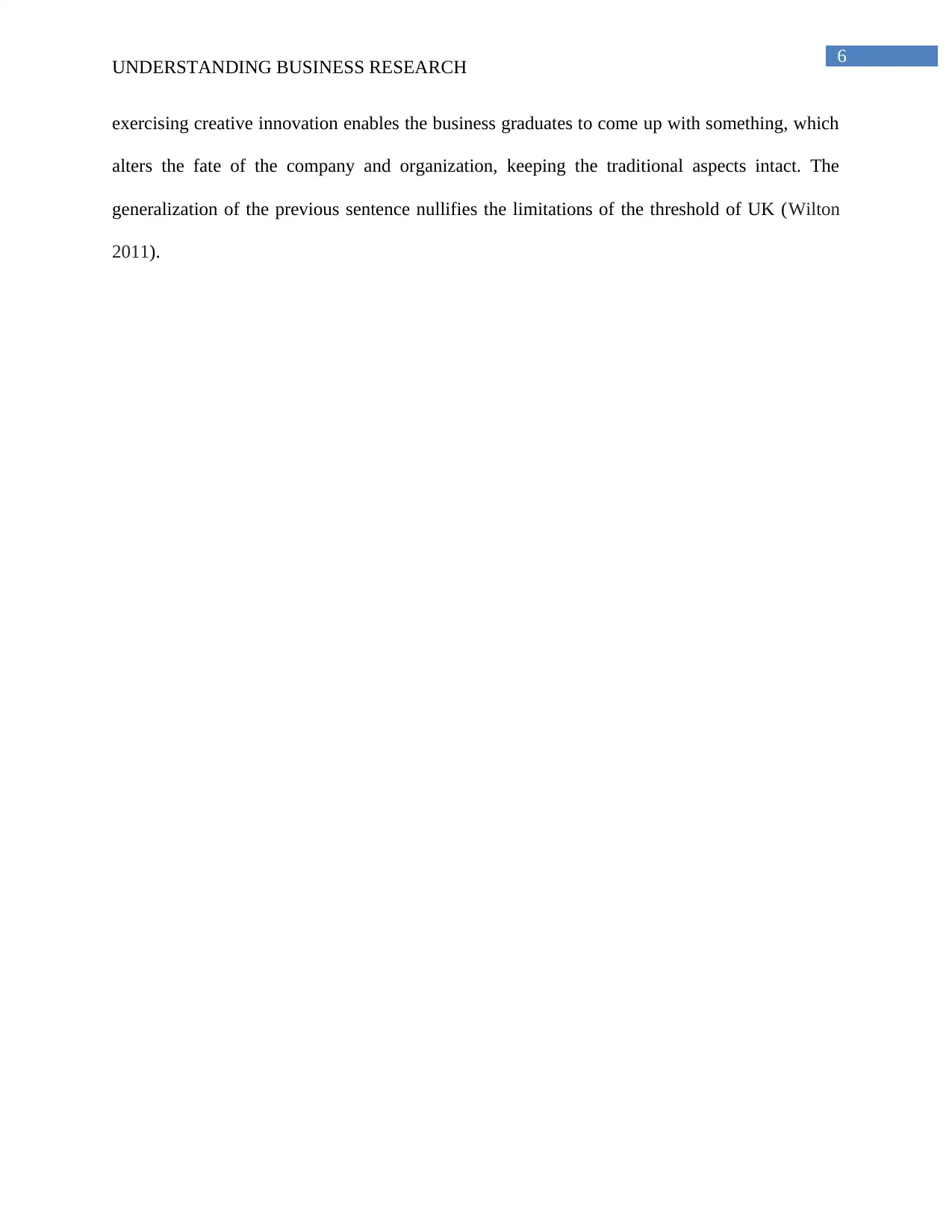
6
UNDERSTANDING BUSINESS RESEARCH
exercising creative innovation enables the business graduates to come up with something, which
alters the fate of the company and organization, keeping the traditional aspects intact. The
generalization of the previous sentence nullifies the limitations of the threshold of UK (Wilton
2011).
UNDERSTANDING BUSINESS RESEARCH
exercising creative innovation enables the business graduates to come up with something, which
alters the fate of the company and organization, keeping the traditional aspects intact. The
generalization of the previous sentence nullifies the limitations of the threshold of UK (Wilton
2011).
Paraphrase This Document
Need a fresh take? Get an instant paraphrase of this document with our AI Paraphraser
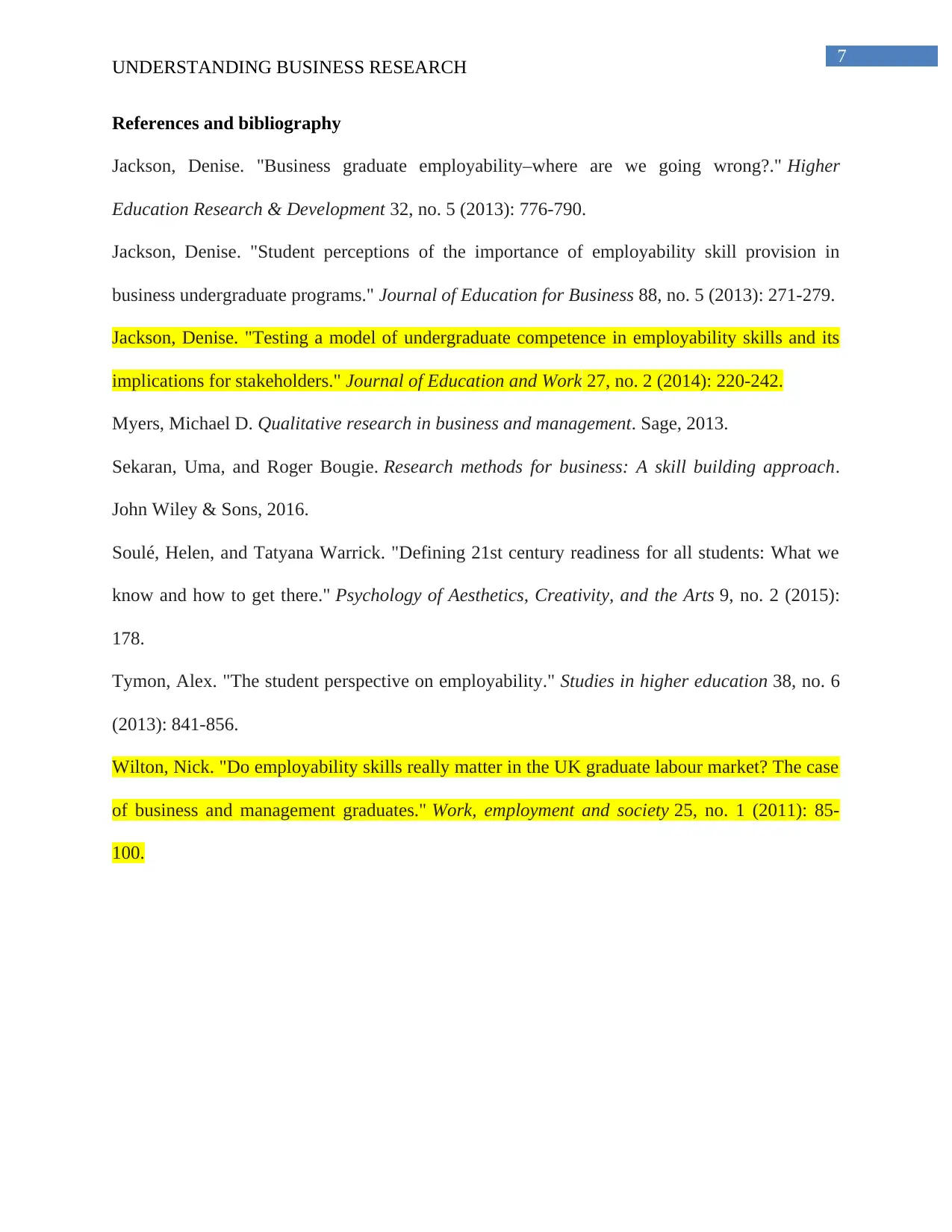
7
UNDERSTANDING BUSINESS RESEARCH
References and bibliography
Jackson, Denise. "Business graduate employability–where are we going wrong?." Higher
Education Research & Development 32, no. 5 (2013): 776-790.
Jackson, Denise. "Student perceptions of the importance of employability skill provision in
business undergraduate programs." Journal of Education for Business 88, no. 5 (2013): 271-279.
Jackson, Denise. "Testing a model of undergraduate competence in employability skills and its
implications for stakeholders." Journal of Education and Work 27, no. 2 (2014): 220-242.
Myers, Michael D. Qualitative research in business and management. Sage, 2013.
Sekaran, Uma, and Roger Bougie. Research methods for business: A skill building approach.
John Wiley & Sons, 2016.
Soulé, Helen, and Tatyana Warrick. "Defining 21st century readiness for all students: What we
know and how to get there." Psychology of Aesthetics, Creativity, and the Arts 9, no. 2 (2015):
178.
Tymon, Alex. "The student perspective on employability." Studies in higher education 38, no. 6
(2013): 841-856.
Wilton, Nick. "Do employability skills really matter in the UK graduate labour market? The case
of business and management graduates." Work, employment and society 25, no. 1 (2011): 85-
100.
UNDERSTANDING BUSINESS RESEARCH
References and bibliography
Jackson, Denise. "Business graduate employability–where are we going wrong?." Higher
Education Research & Development 32, no. 5 (2013): 776-790.
Jackson, Denise. "Student perceptions of the importance of employability skill provision in
business undergraduate programs." Journal of Education for Business 88, no. 5 (2013): 271-279.
Jackson, Denise. "Testing a model of undergraduate competence in employability skills and its
implications for stakeholders." Journal of Education and Work 27, no. 2 (2014): 220-242.
Myers, Michael D. Qualitative research in business and management. Sage, 2013.
Sekaran, Uma, and Roger Bougie. Research methods for business: A skill building approach.
John Wiley & Sons, 2016.
Soulé, Helen, and Tatyana Warrick. "Defining 21st century readiness for all students: What we
know and how to get there." Psychology of Aesthetics, Creativity, and the Arts 9, no. 2 (2015):
178.
Tymon, Alex. "The student perspective on employability." Studies in higher education 38, no. 6
(2013): 841-856.
Wilton, Nick. "Do employability skills really matter in the UK graduate labour market? The case
of business and management graduates." Work, employment and society 25, no. 1 (2011): 85-
100.
1 out of 8
Related Documents
Your All-in-One AI-Powered Toolkit for Academic Success.
+13062052269
info@desklib.com
Available 24*7 on WhatsApp / Email
![[object Object]](/_next/static/media/star-bottom.7253800d.svg)
Unlock your academic potential
Copyright © 2020–2025 A2Z Services. All Rights Reserved. Developed and managed by ZUCOL.





